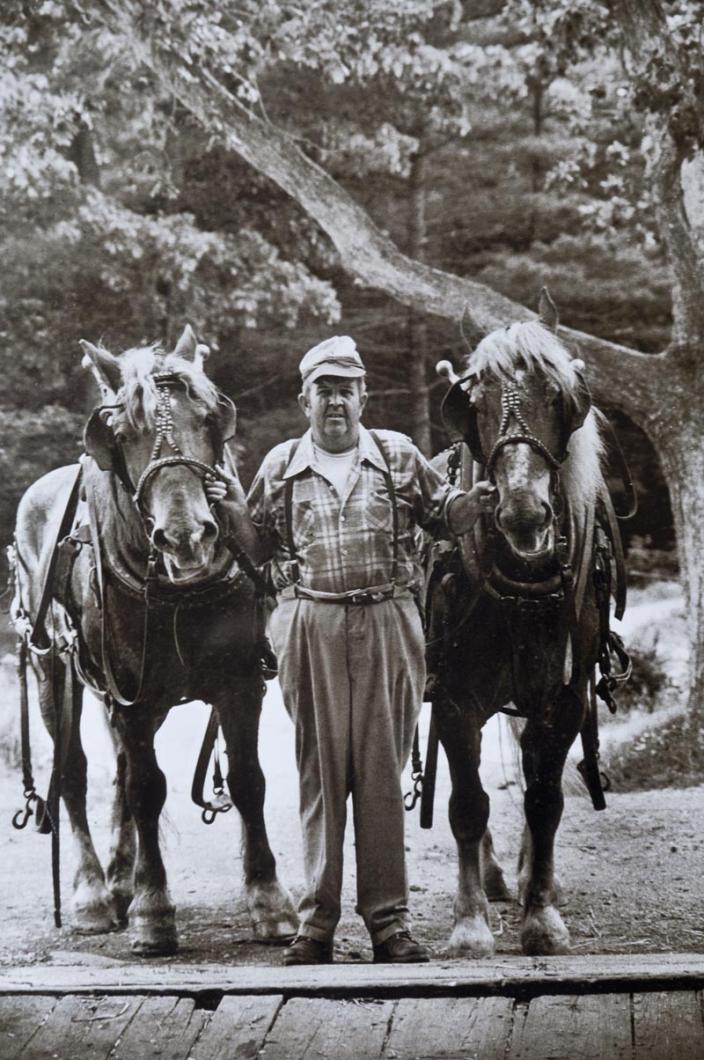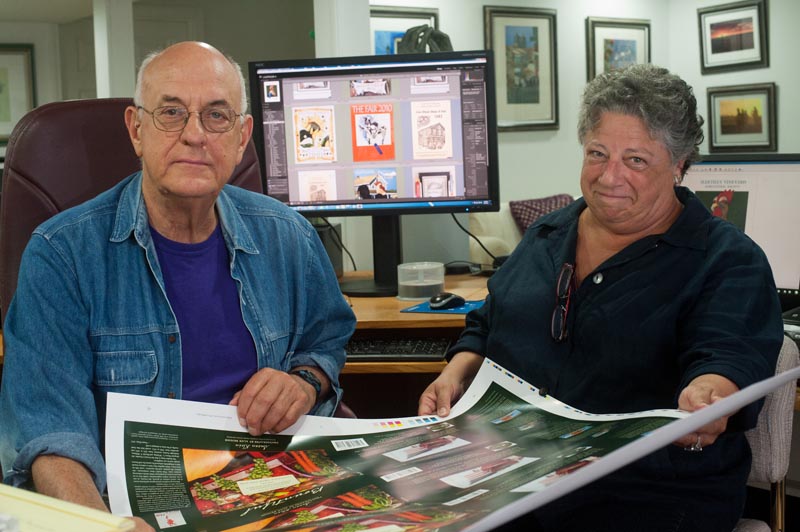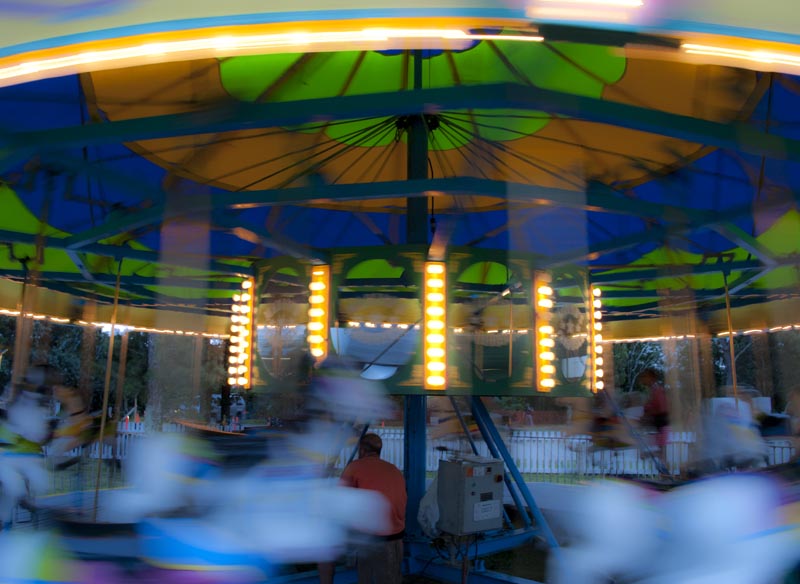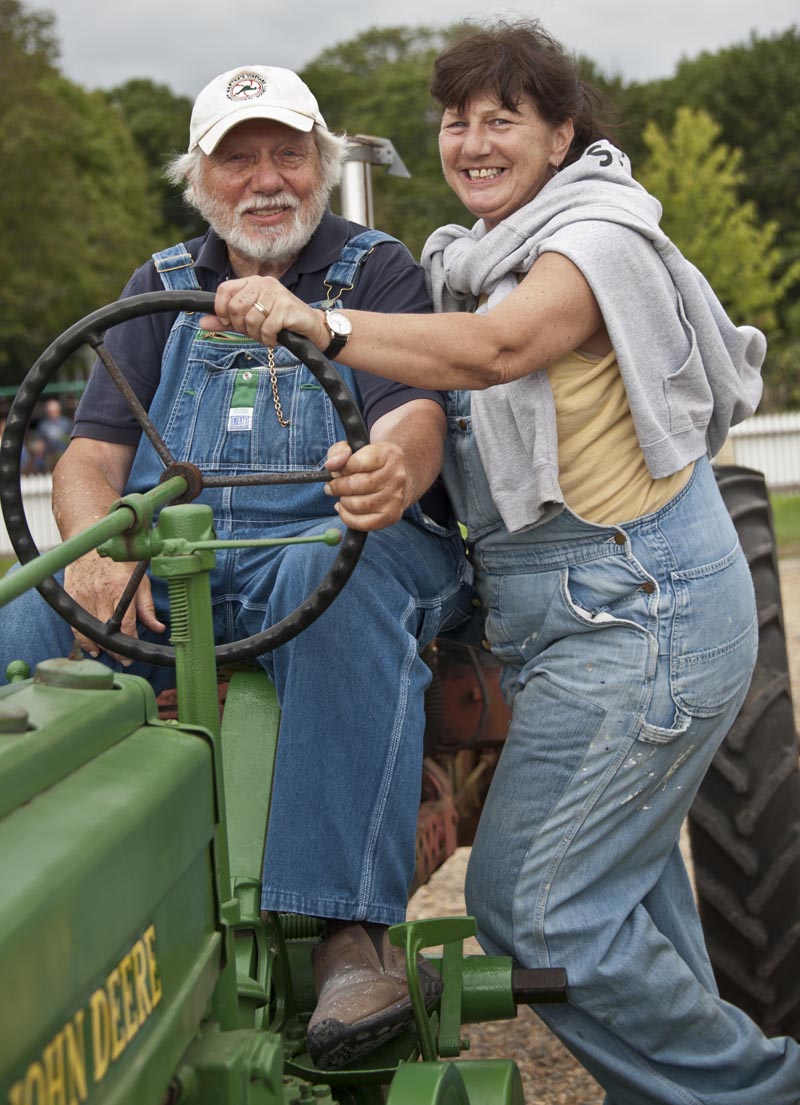The first Martha’s Vineyard Agricultural Society Livestock Show and Fair was held on October 26, 1858: it was announced on September 15 of that year. And thus began a pilgrimage that would be unfamiliar in nature though familiar in spirit to modern-day fairgoers: 1,800 people made their way to the Grange Hall in West Tisbury by horseback, in wagons or on foot.
“Eighteen hundred,” said author Susan Klein. “And the word got out in five weeks. And all the road was dirt! . . . I loved reading the stories of how people walked things. They didn’t transport them by truck. They walked them. And there was this one fellow who had to walk his animals one at a time.”
“These kinds of things were lovely to discover.”
If anyone can understand this devotion to the annual fair, and to the agricultural society, it would be Ms. Klein and photographer Alan Brigish. For the last year and a half, as they’ve worked on their new book, Bountiful: A History of the Martha’s Vineyard Agricultural Society and the Livestock Show and Fair, the duo have immersed themselves in more than 150 years of documents and photographs, noble pumpkins and fat sheep.
The task of hunting down scattered pieces of history wasn’t easy, but the two were aided by some providential twists of fate and the help of Island residents — some from the late 1800s. And now, just in time for the 151st annual fair, they’ve created a book that documents the society, the agricultural hall and the popular fair, complete with restored vintage photographs and a comprehensive set of fair posters.
This book was started during Mr. Brigish and Ms. Klein’s previous collaboration, the award-winning Martha’s Vineyard: Now and Zen. While walking around the fair in 2009, Ms. Klein was looking for some background. “I went to the office and asked where I could find the history of the society,” Ms. Klein said. “There wasn’t one. And so an idea was born.”
The two are no strangers to the fair: Mr. Brigish has photographed the event for 30 years; Ms. Klein said she’s been going to the fair since she had to stand on her tiptoes to peek into the pick-a-duck pond.
Ms. Klein, who served as author and editor, started by trying to find everything that was “extant in hard copy — which was minimal,” she said. It turned out that the historical record was spotty, and required some legwork. So she culled through items donated by individuals, the archives of the Martha’s Vineyard Museum and the microfilm at the Vineyard Gazette, looked through Linsey Lee’s oral histories from the Vineyard, interviewed about 60 people and talked to another 150 people at the 2011 fair.
She was able to track down 120 out of 150 “premium books” from the fairs, the annual schedule of events that once included a record of transactions and reports from society members. The premium books didn’t start until 1865, she said, but that first one did have a short history of the first eight years. (An interesting fact: for a while there was even a premium for the best written report.) They found a handwritten ledger of the first members of the society in 1859, and the five bids to build the hall scrawled on the back of an envelope. Little booklets, some eaten by mice, note winners of sports events (a lad named Carl won the 50 yard dash in 1929).

Available information was affected by the whims of record keeping and Island residents, and the capricious workings of time. “One hundred and twenty years of stuff that’s somewhere. It’s just nobody knows where,” she said. Some records could have been destroyed, or they may be resting in a Vineyard home.
A “magnificent old wood box” at the agricultural society had some valuable documents, including crop statements, from the earliest years of the society.
“What’s so interesting about a process like this . . . we’re talking about the Civil War period. This was a long time ago. It’s scattered all over the Island, a lot of it’s in people’s heads. A lot of it’s in people’s attics, and we had a lot of trouble getting people to go up in their attics,” Mr. Brigish said.
Mr. Brigish, the photographer and marketer, documented a year in the life of the agricultural hall, photographing services and weddings, a Christmas pageant and the winter farmers’ market.
Then there were the iconic fair posters. “A big piece of the fair, and a big piece of the tradition of the fair, is the poster. And people love to hang them in their homes and in their dens,” Mr. Brigish said. “But nobody to our knowledge has a complete set.”
So they tried to assemble a complete set of posters — and were successful. In the book, the posters lead off each chapter.
Mr. Brigish, like Ms. Klein, spent time combing history for hidden gems, looking for historical photos that were publishable, interesting and of decent quality. He was able to find some, mostly going back to the sixties and seventies, and some from the forties and fifties. But there was “almost nothing in the archives” from earlier dates.
“Susan spent hours” — “It felt like years,” Ms. Klein interjected — “in the museum archives and then also in the Gazette’s archives, and we just couldn’t find anything,” Mr. Brigish said.
“And then one day we got a call.”
It was Bonnie Stacy, chief curator at the museum: they had found five boxes of glass negatives (1,163 to be exact), taken “a very long time ago; we think about 100 years ago,” Mr. Brigish said.
The photographs, dubbed the “Basil Welch collection” after the Island resident who first found the slides 50 years ago during house cleaning, turned out to be a gold mine.
The two went through the photos with the museum staff, and pulled the relevant slides. Mr. Brigish, with assistance from the museum, scanned them digitally and restored them. About 30 of the photos are in the book.
“That was one of the greatest experiences of my life as a photographer, being able to uncover a treasure trove, and then being able to work on them and then reproduce them. You look at those pictures today and try to imagine being the photographers who took those pictures and saying, ‘Wow, there’s my work being shown, 100 years later.’ That’s pretty cool.”
“Imagine what it was like for a photographer in those days.”
For the project, Mr. Brigish created photo slide shows featuring music from The Flying Elbows: one slide show is about the Agricultural Hall, and shows the barn raising weekend in 1994 when the new barn, brought from New Hampshire, was built to replace the old Grange Hall.
Another features the Basil Welch collection, which has familiar agricultural and fair scenes: a flock of chickens, an old fire engine, women picking crops in dresses, the Grange Hall, men in top hats, a woman in a long-sleeved dress holding a chicken.
The photos are mostly posed, because earlier cameras did not capture movement well. In one picture, a man who is moving resembles a ghost. “In a sense he is, for us,” Mr. Brigish said.
“History tends to be very dry...I think it was a real challenge here to make this history come alive in a way that would be very compelling . . . I honestly think [Ms. Klein] succeeded brilliantly,” Mr. Brigish said.
The book documents the society and the fair through history: the first few years, the World War II era when the fair was not held for a few years, and the more familiar images of the fair today.
Over time, the fair has grown from 200 to 4,000 exhibits. Compared to the 1,800 people at the first fair, 30,000 plus now attend.
“I fell in love during the process with Beriah T. Hillman,” Ms. Klein said. Mr. Hillman was a Civil War veteran and the secretary of the society from 1876 to 1899 and the president of the society from 1900 to 1912. “I so enjoyed his writing,” Ms. Klein said. “He really was a no-nonsense kind of guy. He wrote copiously.”
Then there was Henry Whiting, the society founder, who “must have been an extraordinary man,” Ms. Klein said. Mr. Whiting was the longest-standing topographer for the United States survey, she said, and he came to the Island as a young man to do a coastal survey. He stayed at an inn in West Tisbury and fell in love with the innkeeper’s daughter. “And pretty much, the rest is history,” Ms. Klein said.
Ms. Klein said she found much to admire in the words of the early founders, written in fancy script. “In the way long ago, they used to describe things in such an interesting fashion,” Ms. Klein said. “They would keep calling the pumpkins ‘noble’ or ‘handsome.’’
An earlier title for the book was “Handsome pumpkins and fat sheep.” Sheep are the only category remaining in which one can win a prize for having the fattest animal, well-fed and ready to go to market.
Last year during the 150th fair, the two documented the entire process, beginning with an early morning trip to the Steamship Authority as the carnival trucks started to roll of the boat. “Here come these carnival rides, all squished up, coming off the backs of trucks, just like anything else that comes to this Island,” Mr. Brigish said. They saw “how this thing just comes together and builds over a series of days, and it just comes together.”
And after four days of blue ribbons and corn on the cob, rides and tractor pulls, they documented the end: a time capsule was buried and all the volunteers rode on the merry-go-round and posed for a photograph.
Ms. Klein said she looks forward to the calm before the storm.
“I just adore the underpinnings,” Ms. Klein said, gesturing to Mr. Brigish’s photograph of the empty fairgrounds on a misty morning, booths and picnic benches at the ready. “I love the emptiness, the shots of empty.”
And the quiet anticipation was a metaphor for the book, she said; the history was there but it hadn’t been gathered. “There was a quiet promise.”
Come the start of the fair on August 16, “I love watching the moment that the hordes arrive with all of their things to get ready to give over to the hall . . . there’s such excitement at that. People have been working on stuff forever. There’s these little tiny runners, sometimes these kids’ first job is at the fair.”
The runners are handed “a plate of cucumbers or some great magnificent carved something or other, a decoy or boat or something. They know where it’s supposed to go.”
These kids will grow up to enter items in the fair and attend the fair, she said. “And that’s where the continuity is, and I think that’s the most precious thing.”











Comments (1)
Comments
Comment policy »